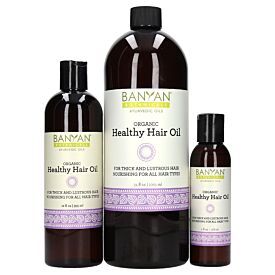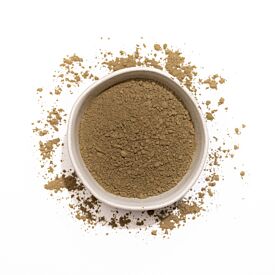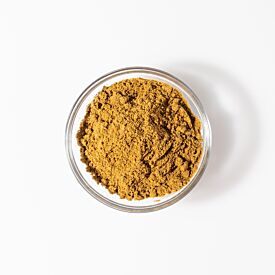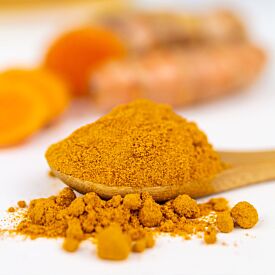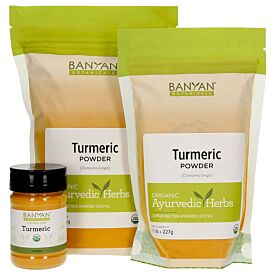An Ayurvedic Guide to Healthy Hair
There are many types of hair out there, and we all want what’s best for ours. After all, the hair is often one of the most prominent aspects of a person’s physical appearance, likely second only to one’s face. And given the choice, who among us wouldn’t want healthy, lustrous hair to style as we see fit?
What follows is an introduction to Ayurvedic hair care—from theory to practice. Our intention is to support you in expanding your understanding of the Ayurvedic approach, and to give you the practical tools to optimize your hair’s strength, abundance, luster, and shine.
In this guide:
- The Importance of Hair Care
- An Ayurvedic Perspective on Hair
- Ayurveda’s Holistic Approach to Hair Care
- How to Support Your Hair from the Outside In
- How to Support Your Hair from the Inside Out
- Your Path to Vibrant, Healthy Hair
The Importance of Hair Care
If our hair didn’t matter to us in a collective sense, there wouldn’t be a multi-billion-dollar hair care industry peddling their products on the market. The problem is that many of these products contain harmful chemicals that can have an extremely detrimental impact on both the hair and critical internal systems like the endocrine and nervous systems.
Unfortunately, most hair products only manage to treat the hair superficially—and sometimes only temporarily—often damaging the hair in the process.
So whether you choose a topical treatment for the hair itself, a more systemic approach, or a combination of the two, Ayurveda aims to address the root cause of the problem—which often originates well beneath the surface.
In fact, one of the foundational principles of Ayurveda is that the strength of agni (the digestive fire) determines the quality of nourishment received by organs and tissues throughout the body, including the hair.
So according to Ayurveda, the health of the hair begins with the food we eat, and depends deeply on our digestive strength—as does the health of every other tissue and system. That said, our bodies are vastly intelligent and its systems exquisitely interdependent, so our hair can also be affected by imbalances outside of the digestive tract, unique personal and hereditary vulnerabilities, as well as our stress levels and the overall quality of our lives.
Common Terms Used to Describe Different Hair Types
Thin: fewer individual hairs on the head.
Thick: an abundance of individual hairs on the head.
Fine: each strand of hair is narrow.
Coarse: each strand of hair is broad.
An Ayurvedic Perspective on Hair
According to Ayurveda, the hair is a byproduct of the bone tissue, as are the nails and teeth, making all of these tissues intimately connected. The hair is also linked to the nervous system and the gut, so if the health of any of these tissues deteriorates, the hair is likely to be affected.
Similarly, if the quality of nutrition available to the deep tissues of the body is compromised, the hair will undoubtedly be impacted.
Your hair, when it is healthy, reflects your constitution—your unique ratio of vata, pitta, and kapha. And because we each have all three doshas in our constitutions, it is entirely possible (common, even) for our hair to express a combination of different doshic characteristics.
In other words, it is rare to find someone with exclusively vata-type hair, pitta-type hair, or kapha-type hair. You will likely recognize traits from at least two doshas in your hair, and possibly all three.

Ayurvedic Hair Types
Healthy Vata-Type Hair is relatively thin, but often a bit coarse, may be straight, curly, or a combination of the two, grows quickly, and can be a bit unruly—potentially making it more challenging to style.
Healthy Pitta-Type Hair is straight, soft, predictable, and of moderate thickness, but very fine.
Healthy Kapha-Type Hair is typically wavy, lustrous, full, strong, coarse, and thick.
If your hair health is currently compromised, it is important to assess your natural hair type based on life-long patterns, before you noticed your hair beginning to change.
This is an important distinction because our culture tends to regard healthy kapha-type hair as especially desirable, and many of us develop the idea that our natural hair type is somehow inadequate.
While most of us stand to benefit from Ayurveda’s rich hair care traditions, we must also learn to celebrate our unique natural beauty along the way.
Common Imbalances
On the other hand, imbalances can and quite often do impact both the strength and appearance of our hair. And this can absolutely be remedied.
The following symptoms may help give you an idea of which dosha(s) may be compromising your hair:
Excess Vata causes the hair to be dry, frizzy, brittle, and lusterless. It also causes the hair to thin, fall out in clumps, become shorter and more difficult to grow out, and present with split ends.
Excess Pitta causes excess heat in the hair follicles, which can damage the hair and lead to premature thinning, early greying, and baldness. For those hoping to mitigate greying hair, managing pitta can be helpful, but it won't necessarily reverse the natural loss of pigment. Some herbs that are said to be good for pitta and hair are amalaki, brahmi, hibiscus, and aloe vera.
Excess Kapha causes excessive oiliness, heaviness, and thickness in the hair.

The Role of Stress
If stress is a familiar player in your day-to-day experience, stress management may actually be an important element of your hair care regimen, particularly with vata- or pitta-type hair imbalances—which are the most common.
From the body’s perspective, the human stress response is geared toward increasing our chances of survival, and it only occurs when the body perceives that our survival may be threatened.
These days, few sources of stress are truly life-threatening, but the nervous system doesn’t know this, and the cascade of hormones released when we are under stress is the same—whether we are cramming to meet a deadline at work or being chased by a hungry lion.
Unfortunately, when stress becomes chronic, it begins to rob many of our tissues of the nutrition they need to maintain optimal health, and it can send the body into a self-perpetuating cycle of depletion.
In this scenario, the bone tissue is vulnerable because the stress response increases the activity of cells that disassemble and break-down bone tissue (osteoclasts), thereby hindering the body’s ability to maintain bone health.
And if the bones are struggling to meet their own nutritional needs, the hair is invariably going to suffer as well.
Ayurveda’s Holistic Approach to Hair Care
At its root, Ayurvedic hair care is largely about rejuvenation—for the hair, for specific tissues that may be affecting hair health, and for the body as a whole.
Ayurveda has an entire limb devoted to rejuvenation (rasayana, in Sanskrit), which is the practice of offering deep nourishment (at a cellular level) to encourage the healing and regeneration of bodily tissues and systems.
If you want a simple way to get started with Ayurvedic hair care, consider our Healthy Hair Bundle, which includes Healthy Hair Oil and Healthy Hair tablets.
How to Support Your Hair from the Outside In
Treating the hair directly is often the most intuitive means of delivering a little extra support to the hair and scalp. When it comes to Ayurveda, this approach can also be a potent tool for improving hair health at a deeper level.
And interestingly, topical applications can be hugely beneficial for the hair, whether or not you are currently experiencing any imbalances.

Benefits of Topical Hair Treatments
- Superficial Tissues Are Receptive. Much like the skin, the hair and scalp are quite capable of absorbing moisture and nutrients that are applied topically.
- Access to Subtle Channels of the Mind. Topical treatments are anything but superficial because the head is covered with potent energy points (marmas, in Sanskrit) that are connected to deeper, subtler channels throughout the mind and body.
- Nourishment Goes Deep. Nutritive treatments applied to the hair and scalp are carried through both physical and energetic channels to penetrate well beyond the surface. In fact, the oils so commonly used in Ayurvedic hair care, act as a potent vehicle for carrying herbal influences deep into the body and the mind.
Here are a few suggestions as to how to nourish and strengthen your hair from the surface inward.
Apply Oil to the Scalp and Hair
A warm oil massage can help naturally cleanse and detoxify the scalp and roots of the hair. This practice also nourishes the cells, rejuvenates dry hair, stimulates circulation in the scalp, and promotes hair growth.
Once a week, apply Healthy Hair Oil or Bhringaraj Oil to the hair and scalp. You can also use Brahmi Oil with a coconut or sesame base for scalp massage to help relax the mind.
How to Oil Your Hair
- Warm the oil and place it in a small bowl.
- Dip the fingertips of one hand in the oil while parting the hair at the top of the head with the other hand, and apply the oil to the scalp.
- Then part the hair in an adjacent location and apply again, moving around the scalp until you have oiled the entire head.
- Next, massage a bit of oil into the length of the hair.
- Finally, spend a few minutes massaging the scalp with small, circular motions to stimulate circulation and encourage the oil to absorb.
- Let the oil sit for 30 minutes or longer. Some like to leave the oil in overnight, but be sure to protect your bedding in some way if you do this.
- When you are ready to remove the oil, apply a gentle shampoo before wetting the hair and rinse with lukewarm water in the shower.
- If necessary, follow with a second shampoo.
If oiling the hair is a new practice for you, here is a helpful instructional video.
Apply Amalaki Paste to the Hair
Amalaki, also known as amla, is a potent rejuvenative, a highly concentrated source of natural antioxidants, and it has a strong affinity for the hair and the bones—making it an effective addition to any hair care routine.
| Recipe: Amalaki Paste |
|
|
In a small bowl, whisk these ingredients together until smooth and apply to the scalp and dry hair either by hand or with a small brush. Then apply a bit of paste to the length of the hair, cover with a shower cap to keep the paste from drying out, and let sit for at least 30 minutes. Rinse with lukewarm water in the shower to remove the paste, using shampoo and conditioner if desired. |
Protect Your Hair from Harm
It is also important to be mindful of what other influences may be impacting your hair.
Be Gentle with Heat. Heat from repeated ironing, blow-drying, or even excessively hot shower water can strip the hair of natural oils, dry it out, damage the hair, and overheat the scalp and the hair follicles.
Avoid Harmful Chemicals. When shopping for hair care products, it's best to use natural shampoos, conditioners, coloring agents, and styling products so as not to introduce harmful chemicals to the hair or the deeper tissues.
Don’t Overwash Your Hair. Overwashing can damage and dry out the hair. If you are used to washing your hair daily, gradually reduce your frequency until you find the rhythm that is right for your hair type.
Take Shampoo Breaks. Rinsing the hair daily with lukewarm water (and without shampoo) will not have the same tendency to strip the hair of its natural oils and is a good option for those who like to style hair while it’s wet.
Brush Your Hair Daily. Ayurveda recommends brushing the hair daily to stimulate circulation at the roots and to encourage robust health throughout. It is best to brush the hair when it is dry to prevent breakage. Consider brushing the hair in different directions for added benefit.
Factor In Your Environment. If you're living in a dry climate, it's important to counteract the dryness both inside and out. Ghee is especially good for internal lubrication. Topically, you can use aloe vera to soothe and cool the scalp or massage your head with Healthy Hair Oil to promote lubrication. And wear a hat when you're out in the sun!
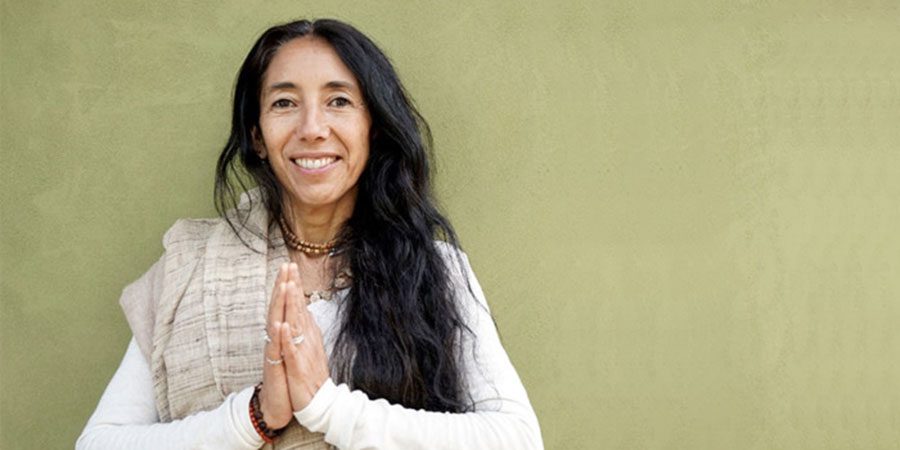
How to Support Your Hair from the Inside Out
Treating the hair directly certainly makes a ton of sense if you’re eager to improve the health and appearance of your hair. But, as we hope is clear by now, offering systemic support is an equally effective means of improving the overall health of your hair and the nourishment it is receiving.
This approach also serves to address system-wide imbalances and begins to correct your symptoms at their root, which has far-reaching health benefits that stretch well beyond the appearance of your hair.
Benefits of Systemic Treatments for the Hair
- Improved Overall Health. When we treat the hair internally and holistically, we can’t help but treat the entire system, which helps improve the overall experience of wellness and vitality.
- Address Deeper Imbalances. This systemic approach looks to the root cause of the problem and delivers balancing influences where they're needed most.
- Bolstered Digestive Strength. When we begin to heal the digestive tract, the body naturally begins to work more efficiently, becoming more and more capable of creating the most highly refined nutrition possible, which benefits every cell and tissue throughout the system. And because the digestive fire is the cornerstone of optimal health, we are also setting ourselves up for improved health and longevity in the long term.
- Employ Herbal and Bodily Intelligence. Certain herbs and formulas have a particular affinity for specific cells and tissues. And because the body is accustomed to receiving nourishment from within, the systemic approach maximizes the intelligence of the herbs themselves and allows them to work in concert with your body’s innate wisdom.
Here are a few suggestions for ways to nourish and strengthen your hair from the inside out.
Take Herbs that Support Hair Health
Because the hair is so intimately connected to other tissues, and to your overall quality of life, Ayurveda offers an abundance of traditional herbal recommendations to nourish and rejuvenate the hair from within.
- Bhringaraj. The benefits of bhringaraj include encouraging abundant hair growth, protecting the hair’s natural color and luster, cooling the head, and calming the mind.
To use, take bhringaraj powder as a tea with warm water (although the taste may make this option less than appealing to most!) or as part of an herbal formula. - Gotu Kola. Gotu kola, also known as brahmi, is highly revered for its capacity to cool, soothe, and quiet the mind. It also acts as a nourishing rejuvenative for the digestive tract, scalp, and hair. You can take it as a tablet or powder to support your health.
- Amla (Amalaki). As mentioned earlier, amalaki balances pitta, helps remove excess heat from the head, and protects the color and luster of the hair. It is available as a tablet or powder.
- Healthy Hair. Healthy Hair tablets include four of the most potent Ayurvedic herbs for optimizing hair health: bhringaraj, amalaki, brahmi, and hibiscus flower. This formula nourishes and detoxifies the hair while encouraging vibrant color, natural shine, and the most thick, lustrous, healthy hair possible.
- Triphala. Triphala tablets serve to cleanse and nourish the digestive tract to optimize the strength of agni, and therefore improve tissue nutrition throughout the system. This formula is also deeply rejuvenative, and can therefore benefit the hair more directly as well.
- Healthy Bones. Healthy Bones tablets are designed to bolster bone health and, because of the close connection between the bones and the hair, can also improve the health and vitality of the hair.
- Chyavanprash. Chyavanprash is a potent rejuvenative jam made primarily of amalaki fruit. It cools and nourishes the digestive system and the deep tissues of the body to promote optimal health and vitality.
- Stress Ease. Stress Ease tablets use deeply supportive herbs, including amalaki and brahmi/gotu kola, and may be appropriate if you recognize stress as a significant factor in your hair health.
Nourish the Hair with Your Diet
Eating a diet of fresh, whole foods and minimizing processed foods and sugars can go a long way toward improving the health of the entire system. Bolster this baseline with adequate fiber from fresh fruits and vegetables, along with healthy proteins and fats.
Beyond that, there are many nutrient-rich foods that are especially supportive of hair health. Increasing your exposure to these foods will bolster the nutrition available to the body and to your hair.
| Good Foods for the Hair |
|
Stay Hydrated
It is equally important to stay hydrated by drinking plenty of water throughout each day. This helps optimize the health of the digestive and circulatory systems and bolsters the body’s capacity to carry out tissue nutrition.
Eat for Your Dosha
If you know which dosha is most active in your hair imbalance, you can take this a step further by following a vata-pacifying, pitta-pacifying, or kapha-pacifying diet.
If you are unsure of which dosha(s) are involved in your particular symptoms, please consider taking our dosha quiz to determine current imbalances.
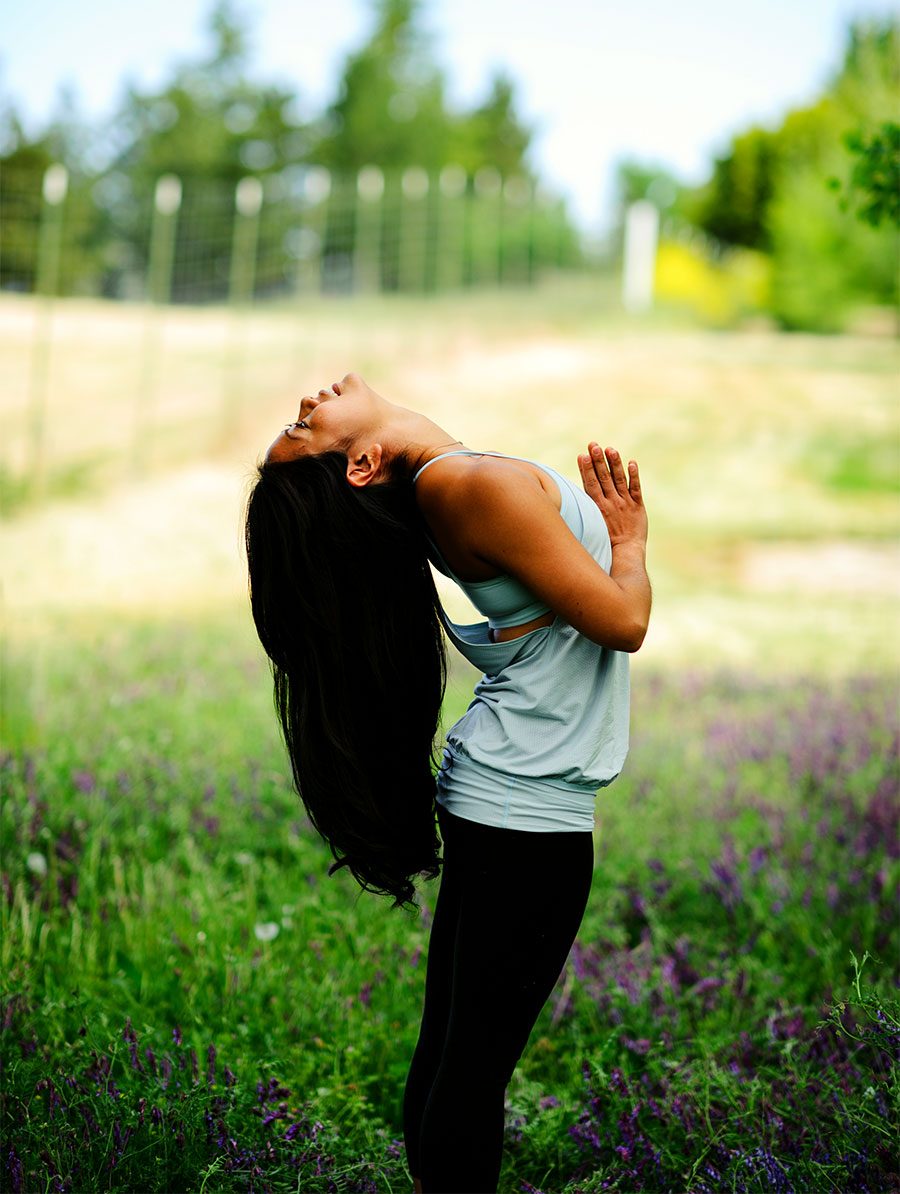
Tend to Your Lifestyle
Because of the fast-paced, high-stress culture we live in, ensuring that you have adequate rest and relaxation can actually go a long way toward improving the nourishment available to tissues throughout your body.
The following practices help reduce stress while improving clarity, balancing the mind and the nervous system, and supporting optimal tissue nutrition. Not surprisingly, you are likely to experience the benefits of these practices in other areas of your life as well.
Make Time to Meditate
Early morning is often an ideal time to meditate, but any time of day will prove beneficial. Even 10–15 minutes can be life-changing.
If you do not have an established meditation practice, consider Empty Bowl Meditation.
Practice Yogic Breathing
Pranayama, or yogic breathing, often complements a meditation practice, although it can be practiced on its own. Consider one or both of these practices:
- Sheetali Pranayama (Cooling Breath) is highly effective at balancing excess heat throughout the body, and kindling the digestive fire without provoking pitta.
- Nadi Shodhana (Alternate Nostril Breathing) offers a potent means of balancing solar and lunar energies throughout the system, supports stress reduction, and is highly effective at balancing all three doshas—particularly vata and pitta.
Your Path to Vibrant, Healthy Hair
As you can see, there is no shortage of options when it comes to Ayurvedic hair care.
The most important thing, of course, is to pursue the options that most align with who you are, what you find nourishing and supportive, and what kinds of experiences feed and excite you.
We hope to continue supporting you in achieving optimal health, radiant beauty, and a vibrant sense of wellness in every aspect of your life.






